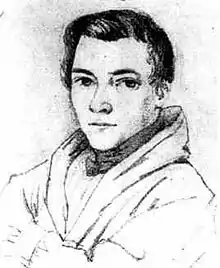Karl Wilhelm Feuerbach
Karl Wilhelm von Feuerbach (30 May 1800 – 12 March 1834) was a German geometer and the son of legal scholar Paul Johann Anselm Ritter von Feuerbach, and the brother of philosopher Ludwig Feuerbach. After receiving his doctorate at age 22, he became a professor of mathematics at the Gymnasium at Erlangen. In 1822 he wrote a small book on mathematics noted mainly for a theorem on the nine-point circle, which is now known as Feuerbach's theorem. In 1827 he introduced homogeneous coordinates, independently of Möbius.[1]
Karl Wilhelm Feuerbach | |
|---|---|
 Karl Wilhelm Feuerbach | |
| Born | 30 May 1800 |
| Died | 12 March 1834 |
| Nationality | German |
| Alma mater | Albert Ludwigs University of Freiburg |
| Known for | Feuerbach's theorem |
| Scientific career | |
| Fields | Mathematician |
| Institutions | University of Basel |
| Notes | |
Brother of Ludwig Andreas Feuerbach | |
Works
- Eigenschaften einiger merkwürdigen Punkte des geradlinigen Dreiecks und mehrerer durch sie bestimmten Linien und Figuren. Eine analytisch-trigonometrische Abhandlung (Monograph ed.), Nürnberg: Wiessner, 1822. online book at Google Books ("Properties of some special points in the plane of a triangle, MIYand various lines and figures determined by these points: an analytic-trigonometric treatment")
- Grundriss zu analytischen Untersuchungen der dreyeckigen Pyramide ("Foundations of the analytic theory of the triangular pyramid")
Notes
- "Feuerbach". sfabel.tripod.com. Retrieved 2020-07-21.
External links
- Works by or about Karl Wilhelm Feuerbach at Internet Archive
- O'Connor, John J.; Robertson, Edmund F., "Karl Wilhelm Feuerbach", MacTutor History of Mathematics archive, University of St Andrews.
- Feuerbach's Theorem: a Proof
- Karl Wilhelm Feuerbach: Geometer
 Media related to Karl Wilhelm Feuerbach (geometer) at Wikimedia Commons
Media related to Karl Wilhelm Feuerbach (geometer) at Wikimedia Commons
This article is issued from Wikipedia. The text is licensed under Creative Commons - Attribution - Sharealike. Additional terms may apply for the media files.